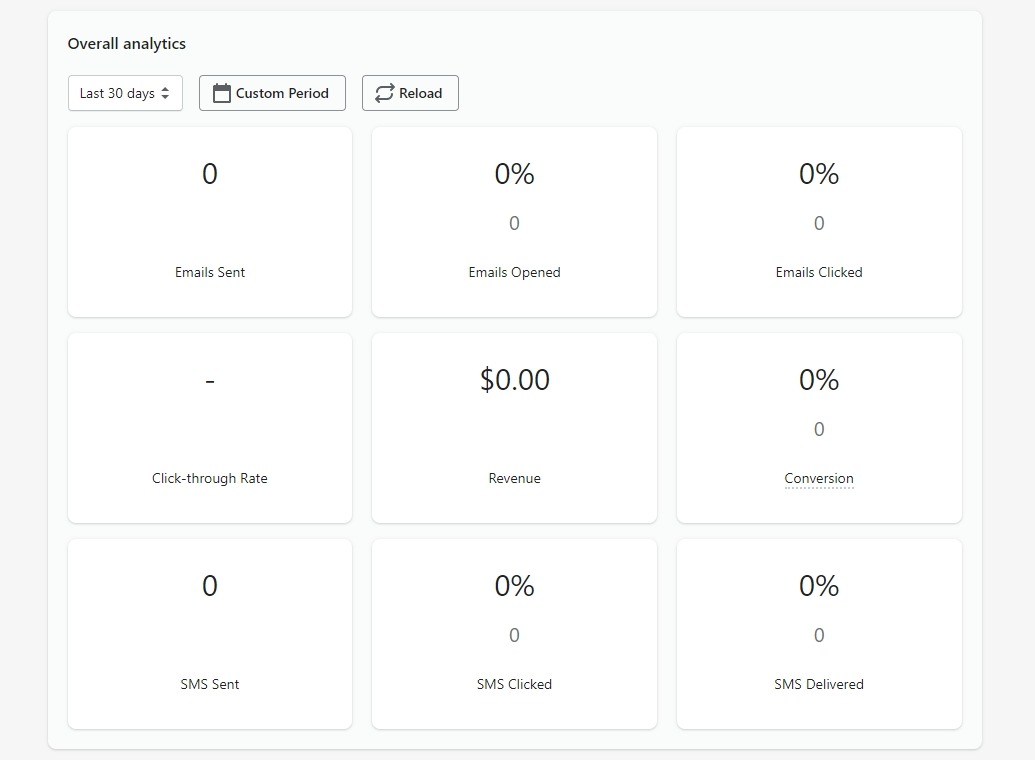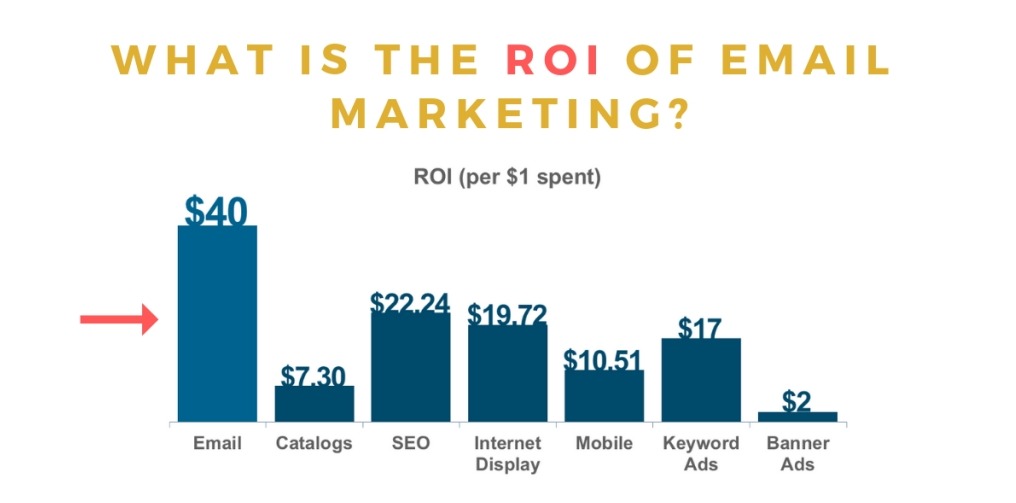Email Marketing ROI: Definition, How to Calculate, & More
You want your marketing investment to engage current customers and generate new leads, but you also need your marketing strategy to be cost-effective. The answer to that is email marketing.
Email marketing is still one of the most fantastic ways to reach and engage with the audience. All businesses big and small can use emails simply because of the incredible ROI and the scalability relative to other mediums. As an email marketing software developer, we have seen thousands of users with different company sizes that are amazed by what they can do with emails at a little cost.
The return on investment of email marketing allows eCommerce businesses to measure how effective their email marketing and promotion campaigns are doing. They can look at ROI to know about:
-
Changes that draw in more revenue
-
How well the emails perform compared to previous months or years
-
Customers reactions to changes in the business
-
Potential problems in the company
Because email marketing still stands as a highly beneficial channel for eCommerce, it’s important for merchants to consider the return on investment of this channel. Or you may question the usefulness of measuring email marketing’s ROI.
That is what we will answer with this article - what you should know about email marketing ROI, how to calculate it, and why. Let’s get started.
What is email marketing ROI?

Return on investment (ROI) is a metric used to evaluate the profitability and efficiency of an investment. In the email marketing case, it is a measure for users to see the profitability and efficiency of an email marketing campaign or all email marketing efforts in general.
As a marketer, all email marketing campaigns should produce a healthy return on investment - and you need to be able to easily calculate it. With a quick glance at the email marketing ROI, businesses can see improvement or signs for adjustment in their email campaigns.
Email marketing ROI counts as much money you spent specifically for the email marketing efforts. This includes creating targeted email campaigns, collecting email lists, advertisements, and other important aspects of email marketing.
According to email marketing performance statistics, the average ROI for email marketing is around 4400%, which means you can make $44 back from just $1 spent on emails.
As you spend the budget and send out email campaigns to customers, you can expect recipients to click on links and access your website. Like that, the email works as an invitation letter for subscribers to go to your website and purchase products from your company.
This is basically the end goal of email marketing. You want potential customers to click on your email campaign’s links. As you increase the website traffic, you also increase the number of people that may purchase something from your business. The process naturally happens since you expose your company to more consumers.
How to calculate email marketing ROI?
After calculating how much money you spent on email marketing and how much profit you earned, you can easily calculate your email marketing ROI.
A simple equation and you can quickly figure out how to calculate email marketing ROI is:
**(Gained money – spent money) / spent money = email marketing ROI (expressed as a percentage).**
First, you take the money gained and subtract it from the money spent, then you divide the subtracted number by the money you spent on email marketing. This will be the result of ROI for your email marketing efforts.
For example, if your company earned $2000 from an email marketing campaign after you spent $800, then you would have a result of ROI of 150%. This means your email campaign earned $1.5 for every dollar you spent on creating or running it. Not a bad result for an email campaign, but I have seen better.
By multiplying the equation by 100, you will know the percentage of the email marketing ROI for your campaign, if you haven’t noticed. However, let’s get to a deeper level of the matter and figure out how to spend each part of the email marketing ROI equation:
How to calculate your spent money
The first step in calculating the email marketing ROI is measuring how much you spent on your email marketing. You may see it as a simple problem, but it does have its complications.
Firstly, the most obvious expense is the ESP (email service provider), and fortunately, the calculation for ESP is pretty straightforward. Any email software or app would have detailed pricing plans so you can measure how much to spend each month or year.
However, this stat alone will not provide a reliable result when calculating email marketing ROI, especially since there are other expenses you should take into consideration - like time spent on creating emails or salary for email marketers.
This means you need to calculate how much time each member in the marketing team spent directly on email marketing and convert the amount of time into an hourly rate.
If all your email marketing expenses go to your email service provider and email marketer’s time, your total spent money is the combination of ESP and team bandwidth.
How to calculate your gained money?
Calculating how much your email campaigns generated is fairly easy if you are an eCommerce business. If your email service provider integrates Google Analytics into the dashboard, it can conveniently trace every sale that comes from your email campaigns. You can measure over a certain period of time or for a particular campaign.
If it doesn’t, you can simply track your sales from emails through an online spreadsheet. If you are a small business and just test the email marketing app out to see if it is a profitable channel, this is the better way since integration with other apps often cost more for email service providers.
The easiest way for measuring gained money is by calculating the value of a lead. You should be able to trace every conversion that can attribute to your email campaigns, including website traffic. Then, multiply the conversion rate by the value of a lead to know the total revenue your email campaigns brought in.
With all this data, then you can calculate your email marketing ROI.

If you use an email marketing app like AVADA Email Marketing, you can easily analyze your campaign performance and calculate the ROI based on the revenue that the campaign generated. You also will know about other important statistics like opens, clicks, and conversions of your email campaigns.
Why should you know about email marketing ROI?
You may question why you should worry about email marketing ROI. You have many different ways for your business to reach out to customers. Many audiences use social media and SMS messaging, so why not shift the investment to those channels instead of email marketing?
The answer is simple: Because email marketing still remains the top candidate when it comes to ROI. As mentioned, you spend just one dollar and on average, you can earn $40 back from email marketing. This is almost double the channel (SEO) with second place for high ROI while email marketing can perform much better. You can rake in money and lead to more business profits with emails.
People throughout the world still check their emails regularly. The number of email users is expected to climb to over 4.3 billion in 2023, showing that the channel is still common and useful for businesses.
Not only email marketing is the most profitable channel, but it’s also a widely-used medium.
Since email marketing still stands out as an important tool for communication and marketing, companies continue to collect ROI data to understand the platform better. This allows email marketers to improve the email marketing strategies and track the progression that they make.
For you, when you deploy an email marketing campaign, you should be able to calculate the ROI so you can know whether it’s bringing you revenue or costing more from the business.
How to use email marketing ROI?

An eCommerce business has many questions about emails when it comes to their audience. After all, their priority is to focus on the customers and effectively meet their needs or provide them with the right service.
Some common questions that an online business owner often asks themselves are:
-
Do the audience like our current emails?
-
Have we used our newsletter to positively affect their opinion?
-
How can we improve our email newsletters?
Email marketing ROI can provide the answers to these questions. If an email marketer notices that the email marketing ROI increases, then the customers probably like the current newsletter and the information inside. If they didn’t like the newsletters, then they wouldn’t click on links in the emails in the first place.
As you try to improve your email campaigns, you will notice your ROI increase or decrease. If the number increases, then you made good changes to the email or provided relevant information that recipients appreciated. If the number decreases, then you may have made some changes that recipients didn’t like. You can adjust your email marketing campaigns according to this information.
When you analyze the changes in your email marketing ROI, you can figure out what your subscribers value and continue to improve your email marketing strategy towards what they desire. If a subject line brings a higher ROI than others, you can copy that style to bring in more customers. Learn and give your audience what they want with your emails.
The improvements you can make with your ROI will depend on your customers. By analyzing your email marketing ROI, you get a general idea of what your audiences want. Keep this in mind as you adjust your email campaigns.
How to maximize email marketing ROI?

You ultimately want your email marketing efforts to grow your business, reach more audiences, and increase profits. A good result with email marketing allows your eCommerce store to succeed. If you don’t know how to improve email campaigns, you can start by improving and maximizing your email marketing ROI.
You may wonder how to maximize your email marketing ROI to grow your business. You can do this by implementing a suitable email marketing strategy, looking over statistics, and finetuning your tactics so you can improve them.
Here are some simple ways to achieve a higher overall email marketing ROI:
-
Better understand the email marketing metrics and what they mean. Also, ensure that you know how to measure the key performance indicators that will keep your emails in a good position with inbox providers and subscribers while generating a higher return for your email channel. Of course, you should also see other channels that your emails can affect.
-
Start measuring your email marketing ROI better. Start small, with specific ROI that you can directly measure, such as the revenue generated by recipients that clicked through and converted. Then, try looking at indirect ROI, such as the difference in subscribers’ activity compared to non-subscribers in your email list.
-
Seek for the absolute returns on your email marketing efforts rather than just for a high rate of return. That means you need to get to another level of calculating email marketing ROI and become more sophisticated with your statistics.
The last step will require you to have some experience with email marketing. But that is what we want to achieve as well, being an expert with the channel, not just a beginner. Some tactics to test with your email campaigns to see a better ROI can be trying to lower your bounce rates, create a better call to action, or improve your subject lines.
If your emails can’t reach the audience, then you can have some issues. So you need to minimize soft bounces and hard bounces. You can do this by removing hard bounces and making notes of soft bounces from your email list.
For email optimization, your customers will see the subject line first. Therefore, create subject lines that make subscribers want to click and open your emails. If recipients don’t click on your emails, then you miss the chance to reach out to them and increase the traffic. Make sure your subject lines draw attention without being too salesman-like.
Also, you want to provide your readers with at least one CTA when they open the email. The CTA is your invitation for customers to do something that can benefit them and your business as well. You should keep your CTA simple so more people are willing to click on it. The more recipients that follow through on your CTA buttons, the more traffic and sales you can gain for your company.
As you find new ways to improve the email marketing strategy, the ROI will naturally rise alongside it. Since ROI reflects the amount of revenue you made compared to the budget you spent, if it increases, you know that you’re doing something that is appealing to your customers.
Start taking advantage of email marketing ROI today!
Now that is all you need to know about email marketing ROI and how email marketing can provide a healthy return for your marketing investment.
It’s easy to see the reason so many companies continue to implement and develop new email marketing strategies. The revenue is no joke and with the low budget to start, emails remain a profitable marketing channel that small or big organizations should all keep an eye on.
Looking at the different ways that email marketing can provide value with its ROI helps you better understand the way to use email marketing and grow your business.
Are you ready for the next step of marketing your business with emails? The AVADA Email Marketing app is ready to help you develop and create a successful email strategy. Check out more of the app on our AVADA website!
New Posts







